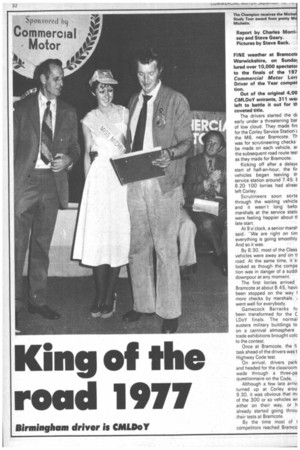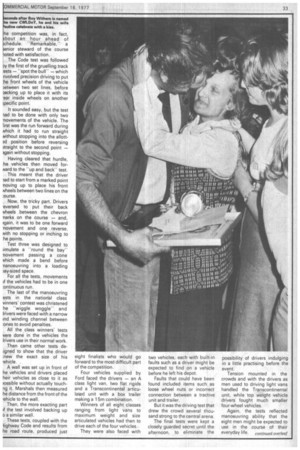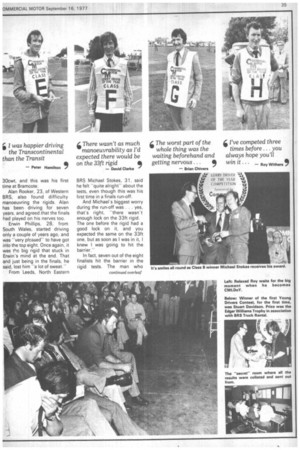King of the road 1977
Page 34

Page 35

Page 36

Page 37

Page 38

If you've noticed an error in this article please click here to report it so we can fix it.
Birmingham driver is CAUDoll
FINE weather at Bramcot* Warwickshire, on Sunda} lured over 10,000 spectator to the finals of the 197 Commercial Motor Lorr Driver of the Year compet tion.
Out of the original 4,00 CMLDoY entrants, 311 wer left to battle it out for th coveted title.
The drivers started the dE early under a threatening bar of low cloud. They made firs for the Corley Service Station c the M6, near Bramcote. Th was for scrutineering checks be made on each vehicle, ar the subsequent road route test as they made for Bramcote.
Kicking off after a delayE start of half-an-hour, the fir vehicles began leaving th service station around 7.45. 8.20 100 lorries had alreac left Corley.
Scrutineers soon sorte through the waiting vehicle and it wasn't long befoi marshals at the service static were feeling happier about ti late start.
At 9 o'clock, a senior marsh said: '"We are right on tim everything is going smoothly And so it was.
By 8.30, most of the Class vehicles were away and on tl road. At the same time, it 51 looked as though the compe tion was in danger of a suddi downpour at any moment.
The first lorries arrived Bramcote at about 8.45, havii been stopped on the way 1 more checks by marshals. went well for everybody.
Gamecock Barracks hi been transformed for the C LDoY finals. The normal austere military buildings to on a carnival atmosphere trade exhibitions brought cola to the contest.
Once at Bramcote, the fi task ahead of the drivers was t Highway Code test.
On arrival, drivers park and headed for the classroom wade through a three-pa questionnaire on the Code.
Although a few late arrivi turned up at Corley arou 9.30, it was obvious that mt of the 300 or so vehicles wt either on their way, or h already started going throu their tests at Bramcote By the time most of t competitors reached Bramco
he competition was, in fact, about an _ hour ahead of .ichedule. "Remarkable," a senior steward of the course loted with satisfaction.
The Code test was followed by the first of the gruelling track :ests — "spot the bull" — which nvolved precision driving to put :he front wheels of the vehicle Detween two set lines, before backing up to place it with its 'ear inside wheels on another specific point.
It sounded easy, but the test lad to be done with only two -novements of the vehicle. The First was the run forward during Nhich it had to run straight zvithout stopping into the allott3d position before reversing straight to the second point — 3gain without stopping.
Having cleared that hurdle, he vehicles then moved forward to the "up and back" test.
This meant that the driver lad to start from a marked point noving up to place his front wheels between two lines on the :ourse.
Now, the tricky part. Drivers .eversed to put their back wheels between the chevron narks on the course — and, sgain, it was to be one forward -novement and one reverse, with no stopping or inching to he points.
Test three was designed to timulate a "round the bay" novement passing a cone which made a bend before nanoeuvring into a loading )ay-sized space.
For all the tests, movements if the vehicles had to be in one :ontinuous run.
The last of the manoeuvring ests in the natiorial class vinners' contest was christened he "wiggle woggle" and irivers were faced with a narrow Ind winding channel between :ones to avoid penalties.
All the class winners' tests were done in the vehicles the 'rivers use in their normal work.
Then came other tests deiigned to show that the driver :new the exact size of his fehicle. .
A wall was set up in front of he vehicles and drivers placed heir vehicles as close to it as mssible without actually touchrig it. Marshals then measured he distance from the front of the vehicle to the wall.
Then, the more exacting part rf the test involved backing up o a similar wall.
These tests, coupled with the iighway Code and results from he road route, produced just eight finalists who would go forward to the most difficult part of the competition.
Four vehicles supplied by Ford faced the drivers — an A class light van, two flat rigids and a Transcontinental articulated unit with a box trailer making a 15m combination.
Winners of all eight classes ranging from light vans to maximum weight and size articulated vehicles had then to drive each of the four vehicles...
They were also faced with two vehicles, each with built-in faults such as a driver might be expected to find on a vehicle before he left his depot.
Faults that could have been found included items such as loose wheel nuts or incorrect connection between a tractive unit and trailer.
But it was the driving test that drew the crowd several thousand strong to the central arena.
The final tests were kept a closely guarded secret until the afternoon, to eliminate the possibility of drivers indulging in a little practising before the event.
Tension mounted in the crowds and with the drivers as men used to driving light vans handled the Transcontinental unit, while top weight vehicle drivers fought much smaller four-wheel vehicles.
Again, the tests reflected manoeuvring ability that the eight men might be expected to use in the course of their everyday life, continued overleaf The light van was parked in its garage bay only inches wider than the vehicle itself, and taken our and around a narrow exit lane while a class C four-wheel rigid was parked in a market-out space, as it might be at the side of the road — a test that was none too popular with some of the finalists.
One class B four-wheel rigid was driven round the edge of a wall which several drivers managed to trim the edge off as they manoeuvred past as close as possible.
But the crowds came to see the Transcontinental unit garag ed and the exhibition of precision driving that the tests needed.
All eight men looked cool and calm as they completed the final test, and then began the nerve-wracking wait for news of the winner.
Clerk of the Course Gordon Asbury shepherded the eight into the stewards' caravan, to await the result.
During the afternoon, results' of the various tests had been posted on a wall. Now came the time to name a winner.
As the crowds broke up and headed towards a converted aircraft hangar for the presents tion of the awards, the eigh men waited nervously.
As they did so, they spoke ti CM about the competition ani how they felt about being on th, threshold, for one of them a least, of becoming the 197' CM L_DoY.
David Clarke, 30, a driver fo the Post Office in Leeds, whi has been driving for 14 years felt the most difficult part of thi run-off tests was handling thi 33ft rigid. "There wasn't a much manoeuvrability as I hai expected on the back end," hi said. David normally drives 30cvvt, and this was his first time at Bramcote.
Alan Rooker, 23, of Western BRS, also found difficulty manoeuvring the rigids. Alan has been driving for seven years, and agreed that the finals had played on his nerves too.
Erwin Phillips, 28, from South Wales, started driving only a couple of years ago, and was "very pIcased" to have got into the top eight. Once again, it was the big rigid that stuck in Erwin's mind at the end. That and just being in the finals, he said, lost him ''a lot of sweat."' From Leeds, North Eastern
BRS Michael Stokes, 31, said he felt -quite alright" about the tests, even though this was his first time in a finals run-off.
And Michael's biggest worry during the run-off was . . yes, that's right, "there wasn't enough lock on the 33ft rigid. The one before the rigid had a good lock on it, and you expected the same on the 33ft one, but as soon as I was in it, I knew I was going to hit the barrier."
In fact, seven out of the eight finalists hit the barrier in the rigid tests. The man who
managed not to hit it ended up as CM LDoY — Roy Withers.
The Royal Navy was also represented in the run-off, by Peter Hamilton, 33, from Portland. It was Peter's fourth appearance in a finals, but first in a run-off.
Peter admitted that he felt tense during the tests, and that the most difficult part was manoeuvring the Ford Transit.
From Showerings, Shepton Mallet, came Brian Chivers, 33, The Most difficult thing for Brian was ''the waiting beforehand and getting nervous . . . and the 33ft rigid.
"I don't think there was enough lock on it, and it tended to be too long to get through the space you judged."
Midlands BRS driver, Jeff Short, 28, seemed to be the only one not suffering from the strain of the occasion. It was, after all, his sixth appearance in the finals, although again, his first time in the run-off.
As far as Jeff was concerned, "all the tests were pretty tough, although I'm used to driving Transcontinentals."
Lastly, it was the turn of Birmingham driver Roy Withers for Midlands BRS.
As he talked, it was obvious he was under some strain, and he admitted: "I was pretty nervous during that run-off. Now, I'm very sticky," he said, wiping the palms of his hands on his trousers.
Then, the results were distributed among the eight men and it was immediately obvious who the victor was. Roy Withers came out on top with a substantial lead of 32 points in front of his nearest rival, David Clarke, who had 168 penalty points.
After about 10 minutes spent studying the results, the men were shown to their places in the front row of seats in the hangar.
The results were read out in reverse order, and when it was announced that Roy Withers had taken the title, the hangar was swamped in a great sound of applause.
Roy wins, together with the highly coveted title, CM LDoY, the following awards: The Coventry Trophy presented by Leyland Truck and Bus, a wrist watch from Chrysler United Kingdom Ltd, £125 from Commercial Motor, £150 from Ford Motor Co Ltd, The Michelin European Study Award 1977 (value, £1,000) to observe road transport operations in France, and a set of books to the value of £30 from the United Road Transport Union.
































































































































